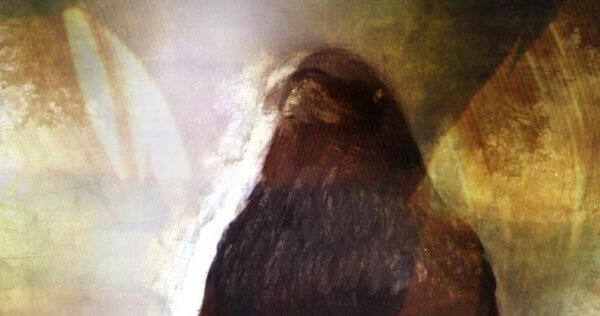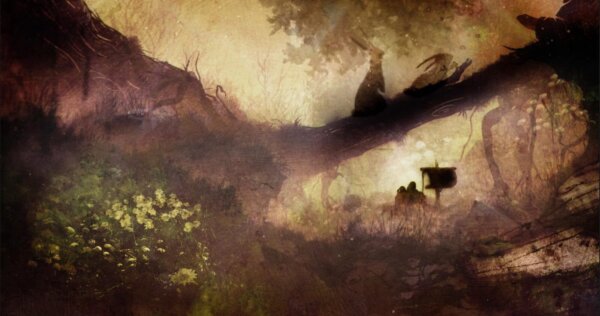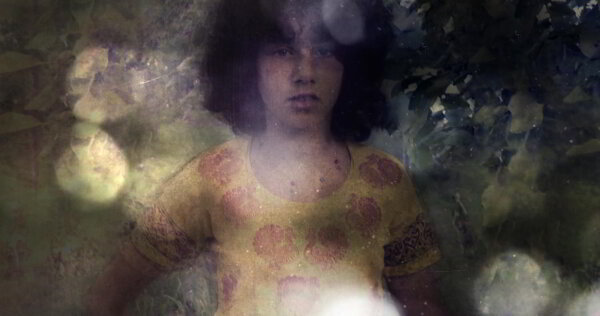Q&A with ‘Thanadoula’ director Robin McKenna
Having established herself as an exceptional documentary filmmaker with her 2019 feature GIFT, inspired by the Lewis Hyde bestseller The Gift: Creativity and the Artist in the Modern World, Robin McKenna has since ventured into mixed-media territory with this year’s animated documentary short Thanadoula, produced with the National Film Board of Canada. With prior live-action work including the award-winning 2007 documentary The Great War Experience as well as shorts for the tenth anniversary season of the Quebec television series La Course destination monde, Robin’s first animated project recounts the story of Natalie as she attempts to connect with her missing sister Annie as an ‘end-of-life doula’, or thanadoula, told through an array of stunning and stirring visual techniques.
With art direction of Elise Simard (whose own filmography includes Breakfast, Opening Hours and the NFB short My Little Underground), the film combines animation and existing footage in a manner that evokes dream states and otherworldly realms in its compassionate telling of a story that embraces the complexity of our attitudes toward death, grief and moving on.
Skwigly spoke with Robin in anticipation of Thanadoula‘s premiere screening at this year’s digital edition of the Ottawa International Animation Festival .
With Thanadoula being your first animated documentary project, can you tell us a bit about your filmmaking background and your primary areas of interest as a documentary filmmaker?
I’ve been making documentaries for 20+ years, starting with La Course destination monde, a cult TV series in Quebec (I grew up in Montreal) where young people travelled the world alone with a camera, making short, creative docs. It was fly-by-the-seat-of-your-pants film school, learning from your own mistakes, finding your voice by making a short film every nine days.
They were like short film poems, kind of documentary haiku. That was my introduction to filmmaking, and the poetic element was something I fell in love with. Along the way I worked as a videographer, did camera work on other people’s films (including The Take, in Argentina, with Naomi Klein) and slowly developed my own projects.
GIFT, inspired by Lewis Hyde’s The Gift, was my first feature doc; it screened in festivals and theatres last year (and was just released on iTunes and Amazon!). I’m also finishing a long-term labour of love, Medicine, about ayahuasca, the Amazonian medicine, with Dr. Gabor Maté. I think between these films and Thanadoula, certain themes recur—maybe a quality of “magic realism,” of trying to capture the invisible. Not an obvious thing to do using the tools of observational documentary! Which is why animation was such an inspiring choice for this project…
How did you come to meet the film’s subject Natalie, and how in turn did that lead to documenting her story as a film?
I came to know Natalie via mutual friends in Montreal. The first time we met, I mentioned the ayahuasca film I was working on with Gabor Maté.
She told me she knew Gabor personally: he had been her sister Annie’s doctor when Annie ended up in Vancouver’s drug ghetto, the Downtown Eastside. She began telling me the story of her extraordinary older sister, who existed “between worlds,” but didn’t fit into this one.
Natalie had a crow feather tattooed on her arm. She spoke about the significance of the crow, which seemed connected to her sister after she disappeared… encounters that felt somehow like Annie, appearing to her. She talked about the idea of the crow as messenger between the worlds of the living and the dying, and how, through losing Annie, she had found her calling, helping people cross over to the other side.
Her story was like real-life magic realism, and I kept thinking about it: this idea of a realm between worlds, and the extraordinary work she did, speaking to our culture’s fear of death and dying. As a documentary filmmaker, I wondered how I could tell her story in a way that could represent this blurring of lines, between the worlds of the living and dying—bringing in the element of the crow as messenger between the two.
The film is steeped in beautifully-visualised mysticism and spirituality, much of it oriented around ‘crow’ magic – did these elements have a specific cultural relevance to you as a filmmaker beyond the imagery itself?
I knew about the crow/raven from Lewis Hyde’s book Trickster Makes This World, about trickster myths—the trickster as boundary-crosser:
“All tricksters are ‘on the road.’ They are the lords of in-between. A trickster… is the spirit of the doorway leading out, and of the crossroad at the edge of town. He is the spirit of the road at dusk, the one that runs from one town to another and belongs to neither.”
I had always been fascinated by that character, the boundary-crosser, moving between worlds. And I loved the idea of trying to bring that concept into the film’s treatment—that blurring of boundaries, the feeling of being between worlds, neither here nor there.
Had you considered other filmmaking approaches before landing on the mixed-media technique used, and if so what ultimately appealed about this approach for it to win out?
We did start out using 3D animation, mixed with hand-drawn elements, with the super-talented Daniel Gies: he was an amazing collaborator in the early stages, creating the animatic and original design. But I only had a small arts grant to make the film; what we were trying to do was pretty ambitious, and we began to realize that we couldn’t complete what we had started with the budget we had.
So I needed to go back and rethink the treatment: what would be more feasible and also more reflective of the original intention, this idea of blurred boundaries/between worlds?
I had come across Elise Simard’s work when I was first starting to think about the film, and totally fell in love with it—so strange, delicate and ethereal, unlike anything I’d ever seen. As we developed the visual aesthetic and approach, her work was always in the back of my mind—exactly how I’d imagined the film would look and feel.
After a long process of notes and creative conversations, Jelena Popović and the NFB signed on as co-producers (yay!) and together we reached out to Elise, who Jelena had worked with before. In terms of treatment, the idea was that we would essentially start over (!!) using rotoscoping and 2D, mixed-media layers, integrating the elements we had created with Dan, but kind of “remixing” them, with Elise as master magician of compositing and art direction. We also wanted to bring the documentary nature of the film more to the forefront, integrating family photos and archives, and doing some actual shooting with Natalie, the film’s protagonist.
We’d done some beautiful initial work with Dan, and through this process it morphed into something else—more feminine, mysterious, less clearly defined—which, in the end, was exactly the right treatment for the subject matter, the soul of the film.
Beyond her role as an interview subject did Natalie have any involvement in or influence on the aesthetic development of the film, or perhaps any other areas?
Natalie became a good friend in the process of making the film. In terms of the “writing” of the film, it came from some long interviews/conversations I had with her, which I pared down and shaped into a storyline. (In the course of editing, we removed more and more words, really ending up with the bare-bones essentials.) Nat had some feedback about certain lines and ideas… we refined the script together, over the years (!) it took to make the film.
In the live-action sequences, she played herself, working from the animatic/scenes we had blocked out. (We would joke with our friends that she was becoming a “cartoon character” now—we’d create death doula action figures and merchandise!) 🙂
She also did some archival digging into family photos, home movies, audio recordings, and Annie’s journals… some of which she had never seen or heard, so that was an emotional process for her, kind of reconnecting to Annie through the journey of the film.
Can you describe your working relationship with Elise and what she was able to bring to the project visually?
By the time Elise got involved, we had many existing elements to work with: Dan’s backgrounds and textures, effects we had created, Natalie’s family archives. Elise liked the idea of taking these “found” elements and integrating/layering them with live-action footage I would shoot with Natalie, that we would rotoscope. With Jelena, and animator Sharron Mirsky, the four-way creative process was super-collaborative—exploring the treatment, how we would integrate the archives, treat the photos. (Making a film dealing with sisterhood, it was very cool to bring it to life through this process of close collaboration between creative women…)
Elise’s unique visual sensibility meant a different lens through which to look at what already existed. For example, the opening and closing scenes at the deathbed, which had been conceived as dark/candlelight: she proposed using a white background, very light, resulting in something more unexpected. Her gift with light and shadow is woven through the film: the highlights on the photos of the sisters in the forest, the waving shadow of a branch in the graveyard.
She works a lot with layers, transparency and opacity, in a very intuitive way. I think integrating all these found elements, the animation, and her own special layers, through this organic process, resulted in something strange and beautiful and unusual. Every frame becomes a kind of moving painting, with so much richness of detail… it’s definitely a film meant to be seen on the big screen. Still hoping this might be possible in the coming months—at least in some of the places the film is screening!
Are you able to elaborate on the image generation process itself, such as what animation techniques/processes were combined with existing footage, and if the live-action footage or images were pre-existing or created for the film specifically?
Part of the new treatment/approach to the film was to shoot live-action scenes with Natalie, which we would then rotoscope. We did some lighting to create atmosphere and shape the scenes, and shot them with Natalie (with my mom as the dying person she was accompanying!). I did an initial edit; from those sequences, we extracted still images, which were printed in black and white, then inked by Sharron.
We wanted to create that softness in the treatment, the feeling of “blurred lines.” Elise used sandpaper and dirty fingers to blur out some of the detail in the images, removing their crispness.
Do you see yourself continuing to use animation in your future projects?
I’m actually developing a new feature doc around psychedelics/entheogen research, involving “inner visions” and dreamscapes. I’m exploring using animation, similar to what we did with Thanadoula: rotoscoping live footage, using layers to blur the lines between the real and the imaginary. Maybe even with Elise, if I’m so lucky… 🙂 We’ll see!
Thanadoula screens as part of OIAF‘s Short Competition 2 screening which streams live September 24th 7pm EST and will be available in On Demand October 3rd-4th. See more of the work of Robin McKenna at gaudetefilms.com




